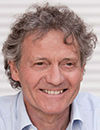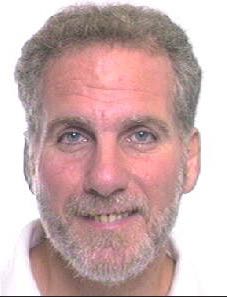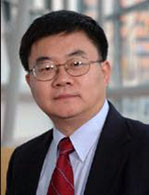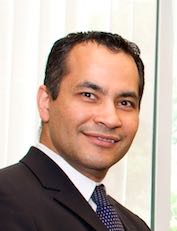08:00 | Conference Registration, Coffee, and Breakfast Pastries |
|
Opening Plenary Session: Opportunities in 3D-Printing and Organ-on-a-Chip Technologies and Approaches |
| |
|
Plenary Session Chairman: Jon Rowley, Ph.D., Founder and CEO, RoosterBio |
| |
09:00 |  | Keynote Presentation Bioprinting in Regenerative Medicine and Beyond
Gabor Forgacs, Professor, University of Missouri-Columbia; Scientific Founder, Organovo; CSO, Modern Meadow, United States of America
|
|
09:30 |  | Keynote Presentation Organs-on-Chips: In vitro Surrogates for Accurate Human Bioemulation
Geraldine A Hamilton, President/Chief Scientific Officer, Emulate Inc, United States of America
All too often conventional cell-culture methods and animal testing fail
to serve as true predictive models, unable to recapitulate human organ
function or physiology. These shortcomings compel us to pursue more
"humanized" alternatives to the traditional approaches, as we strive to
attain authentic human response. This discussion will explore the
bioemulation capabilities of our Organs-on-Chips technology and its
potential use within drug development and safety pharmacology.
Organs-on-Chips are in vitro surrogates of the human body that may
accelerate the identification of novel therapeutics, ensure safety and
efficacy, and reduce significant drug development costs. We review our
platform and its incorporation of tissue-tissue interfaces, biochemical
cues, mechanical forces and physiological perfusion in an organ-specific
context. Our experience from organs such as the lung, liver, intestine
and kidney consistently shows that these bioengineered microenvironments
lead human cells to assume in vivo function and effectively reproduce
organ-level physiology and disease responses. Based on experimental data
collected from this platform, it is evident that Organs-on-Chips stand
as a more predictive, human-relevant alternative to traditional drug
development methods. |
|
10:00 |  | Keynote Presentation Can Multi-Organ Chips Be Used for Drug Development Studies?
Michael Shuler, Samuel B. Eckert Professor of Engineering, Cornell University, President Hesperos, Inc., United States of America
Effective human surrogates, created from combining human tissue engineered constructs with microfabricated systems, could have a major impact on drug development, particularly in making better decisions on which drugs to take into human clinical trials. Early prediction of human response would be crucial to such decisions. Our designs are guided by physiologically based pharmacokinetic models. We will describe possible approaches to use “pumpless”, low cost platforms to build such human surrogates for evaluation of potential response to drugs. |
|
10:30 | Coffee Break and Networking |
11:00 |  | Keynote Presentation Microengineered Cell and Tissue Systems for Drug Screening and Toxicology Applications: Evolution of In-Vitro Liver Technologies
Martin Yarmush, Founding Director of the Center for Engineering in Medicine, Massachusetts General Hospital and Harvard Medical School, United States of America
|
|
11:30 | The Patent Landscape of Organs-On-a-Chip
Robert Esmond, Director, Sterne, Kessler, Goldstein & Fox P.L.L.C, United States of America
Organs-on-a-chip have present-day real-world uses such as for the
preclinical testing of drugs. Thousands of patents have been filed on
various aspects of organs-on-a-chip, including their manufacture. A
company seeking to make, use or sell an organ-on-a-chip must consider
the patent landscape. This talk will focus on ways to protect
organs-on-a-chip innovation, patent filings directed to organs-on-a-chip
technology, certain exceptions to patent infringement, as well as the
possibility of future litigation. |
12:00 | Networking Lunch, Visit Exhibitors and View Posters |
13:30 |  Technology Spotlight: Technology Spotlight:
3D Bio-printer to Print Cornea and Meniscus
Caddie Wang, CEO, Qingdao Unique Product Develop Co., Ltd
The most difficulties to overcome in traditional preparation of artificial cornea are scaffold support strength and optical properties, as well as internal structure controllability and contour curvature of artificial cornea. Meanwhile, the orientation and arrangement of corneal cells on scaffolds are issues too. 3D printing technology offers the opportunity of molding complex organs based on its high precision and personalization. 3D printing based on different parameters in various ages, creates personalized mold and produces individualized simulated artificial cornea. As for the medical treatment of meniscus injury, the classic methods are repairing, resection or transplantation. However, 3D printing meniscal scaffolds, choosing biodegradable materials to meet biocompatibility and mechanical properties, can be well controlled the morphology, structure and porosity. Qingdao Unique Product Develop Co., Ltd developed this 3D Bio-printer which prints a variety of biomaterials and cells simultaneously. On the basis of different biomaterial and densities in human tissue structure, the build platform with four nozzles is designed to print multiple biomaterials in one object. Our 3D Bio-printer has the capacity of fabricating scaffolds using the widest range of materials, such as PCL (polycaprolactone), HA (hydroxyapatite), TCL (tricalcium phosphate), P(CL-LLC), collagen, fiber and chitosan etc.
|
|
Session Title: Emerging Technologies and Trends in 3D-Printing |
| |
14:00 |  | Keynote Presentation The Next 25 Years of 3D Printing
Hod Lipson, Professor, Cornell University, United States of America
Additive manufacturing has evolved over the last three decades from limited and expensive prototyping equipment in the hands of few, to commodity production tools available to almost anyone. It’s been broadly recognized that this burgeoning industrial revolution will transform almost every industry, and every aspect of our lives. But where will this technology go next? This talk will describe the underlying disruptive future of 3D printing: From printing arbitrarily complex shapes to creating new kinds of materials, and ultimately, moving from fabricating passive parts to printing active, integrated systems, including electronics, actuators and sensors. Will we be able to print a robot that will walk out of the printer, batteries included? |
|
14:30 |  | Keynote Presentation Simple Approaches for Complex Structures: Biofabrication with Multi-Channel 3D Plotting
Michael Gelinsky, Professor and Head, Center for Translational Bone, Joint and Soft Tissue Research, Faculty of Medicine, Technische Universität Dresden, Germany
By means of 3D plotting scaffolds and cell-loaded constructs consisting of a variety of different biomaterials can be fabricated easily. With a novel biopolymer blend open porous, cell-loaded structures of clinically relevant size can be manufactured. Other developments describe the processing of hollow strands as artificial vascular structures and those consisting of two different biomaterials, organized in a core/shell fashion. |
|
15:00 | 3D Biofabrication of Complex Living Cardiovascular Tissues: Past, Present, Future
Jonathan Butcher, Associate Professor, Biomedical Engineering, Cornell University, United States of America
Cardiovascular disease remains a leading cause of death worldwide.
Despite their potential, achieving functional living tissue replacements
has been an elusive “Holy Grail” for the last two decades. Among the
challenges is that natural tissues are highly complex, hierarchical
structures that are difficult to replicate. Tissue biofabrication
technology, in particular 3D tissue printing, has made significant
strides over the past 5 years to close this gap. 3D tissue printing has
the capacity to prescribe both macro and microstructural environmental
cues that are essential for coordinating whole tissue function. We
discuss recent findings on two prominent applications: trileaflet heart
valves and vascularized tissue flaps. |
15:30 | Coffee Break and Networking |
16:00 | High-throughput Generation and Characterization of Cellular Aggregates for 3D Bioprinting
Jordan Miller, Assistant Professor of Engineering and Founder of the Advanced Manufacturing Research Program, Rice University, United States of America
|
16:30 | Print and Play Microfluidics
Albert Folch, Professor of Bioengineering, University of Washington, United States of America
Biologists and clinicians typically do not have access to microfluidic technology because they do not have the engineering expertise or equipment required to fabricate and/or operate microfluidic devices. Furthermore, the present commercialization path for microfluidic devices is usually restricted to high-volume applications in order to recover the large investment needed to develop the plastic molding processes. We are developing microfluidic devices through stereolithography, a form of 3D printing, in order to make microfluidic technology readily available via the web to biomedical scientists. The Folch Lab’s long-term mission is to make microfluidic devices as easy to use as smartphones. 3DSkema is a web marketplace founded by Albert Folch that will facilitate the exchange and evolution of digital designs for 3D-printing. |
17:00 | Engineering Tissue Microenvironments Informed by Development, Healing and Disease
Catherine Kuo, Assistant Professor, Tufts University, United States of America
Tendons are critical tissues of the musculoskeletal system that transfer forces from muscle to bone and stabilize joint structures. Despite surgical intervention, injured or diseased tendons are challenged by reparative wound healing responses that result in scar tissue and mechanical dysfunction. This significant problem has motivated efforts to enhance in vivo healing and also to generate tissue replacements. We are systematically characterizing structure-property relationships of these load-bearing tissues during development, healing, and disease progression in order to identify design parameters for engineered tissues. Specifically, we are designing scaffolds and mechanical loading bioreactors to present cells with healthy, injured, and diseased microenvironments. Our objectives are to engineer tissues as functional replacements and also as research platforms for the development of therapeutics to treat fibrosis and other aberrant musculoskeletal tissue conditions. |
17:30 |  | Keynote Presentation Microtissue Building Blocks for 3D Tissue Fabrication
Shoji Takeuchi, Professor, Center For International Research on Integrative Biomedical Systems (CIBiS), Institute of Industrial Science, The University of Tokyo, Japan
Large-scale 3D tissue architectures that mimic microscopic tissue structures in vivo are very important for not only in tissue engineering but also drug development. In this presentation, I will talk about a bottom-up tissue construction method using different types of cellular building blocks (eg. cell beads and cell fibers). For example, a cell-encapsulating core-shell hydrogel fiber was produced in a double coaxial laminar flow microfluidic device. When with myocytes, endothelial, and nerve cells, they showed the contractile motion of the myocyte cell fiber, the tube formation of the endothelial cell fibers and the synaptic connections of the nerve cell fiber, respectively. By reeling, weaving and folding the fibers using microfluidic handling, higher-order assembly of fiber-shaped 3D cellular constructs can be performed. Moreover, the fiber encapsulating beta-cells is used for the implantation of diabetic mice, and succeeded in normalizing the blood glucose level. |
|
18:00 | Universal Microfluidic Acoustic Printing (UMAP) for Life Science Research
Tingrui Pan, Professor, Department of Biomedical Engineering, University of California-Davis, United States of America
Microfluidic acoustic printing has been recently introduced, utilizing its nature of simple device architecture, low cost, non-contamination, scalable multiplexability and high throughput. In this talk, we will introduce this novel impact-based droplet printing platform utilizing a simple plug-and-play microfluidic cartridge driven by cantilever piezoelectric actuators. Such a customizable printing system allows for ultrafine control of the droplet volume from picoliters (~10nL) to nanoliters (~100pL), a 10,000 fold variation. The high flexibility of droplet manipulations can be simply achieved by controlling the magnitude of actuation (e.g., driving voltage) and the waveform shape of actuation pulses, in addition to nozzle size restrictions. Detailed printing characterizations on these parameters have been conducted consecutively. A multichannel impact printing system has been prototyped and demonstrated to provide the functions of single-droplet jetting and droplet multiplexing as well as concentration gradient generation. Moreover, several biological assays have been implemented and validated on this flexible printing platform. Therefore, the microfluidic acoustic printing system could be of potential value to establishing multiplexed micro droplet reactors for high-throughput life science applications. |
18:30 | Cocktail Reception: Premium Beers, California Wines, Appetizers and Networking on the 15th Floor of the Wyndham Boston Beacon Hill with a View of Boston and the Charles River Sponsored by MIMETAS |
20:00 | Close of Day 1 of the Conference |











